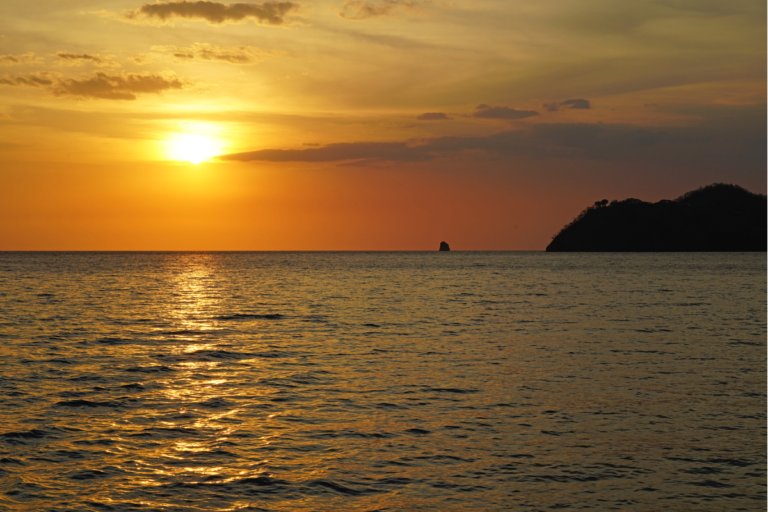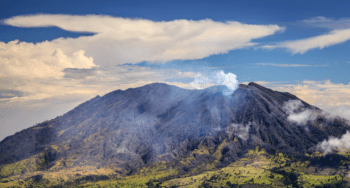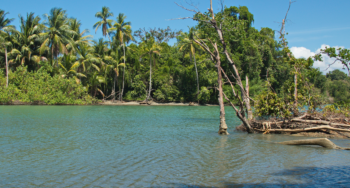Costa Rica Weather: What's Covered
Costa Rica’s weather varies dramatically across 12 microclimates within a country smaller than West Virginia. Guanacaste stays bone-dry December-April while the Caribbean gets rain. The Central Valley enjoys an eternal spring at 60-80°F year-round. Understanding regional patterns helps you pick the right destinations and vehicle type for road conditions.
Quick Facts:
- Pacific coast: Predictable dry season (Dec-Apr) with zero rain in Guanacaste; afternoon storms May-Nov
- Caribbean side: Opposite patterns—driest March-April and September-October when Pacific gets drenched
- Mountain regions: Monteverde stays 60-70°F year-round with constant mist; Arenal is best viewed 6-8 AM before clouds form
- Vehicle impact: 4WD essential for Monteverde year-round and remote areas during the green season
- Temperature swings: Drop 4,000 feet from Central Valley to coast—gain 15°F in 90 minutes
Top 3 Weather-Smart Strategies:
- Guaranteed sunshine – Visit Guanacaste January-April for zero rain and perfect beach days
- Best value – Green season (May-November) brings 30-50% savings with morning sunshine, afternoon showers
- Weather insurance – When the Pacific gets soaked in October, the Caribbean often stays dry
Plan activities around morning hours during the green season when skies stay clear before afternoon storms roll in.
If you need any help with a Costa Rica car rental, contact us now!
Planning a trip to Costa Rica and can’t figure out when to visit where? You’re not alone. Costa Rica packs an incredible 12 different microclimates into a country smaller than West Virginia. The weather in Guanacaste can be completely different from what’s happening just a few hours away in the Central Valley.
After years of helping travelers navigate Costa Rica’s diverse weather patterns, here’s what really matters: understanding regional climate differences isn’t just about packing the right clothes. It’s about timing your activities, choosing the right vehicle, and knowing which routes to avoid during certain seasons.
Let’s break down Costa Rica’s weather patterns by region and month, so you can plan your perfect trip based on what you actually want to experience.
What Creates Costa Rica's Crazy Weather Patterns?
Costa Rica’s weather isn’t just about “dry season” and “rainy season.” The country’s location between two oceans, combined with mountain ranges that rise over 3,800 meters, creates distinct climate zones that can change dramatically within short distances.
Here’s what actually shapes the weather you’ll experience:
Elevation changes everything. San José sits at 1,200 meters and enjoys spring-like weather year-round, while Guanacaste’s beaches bake at sea level. That 90-minute drive from the Central Valley to the Pacific coast? You’ll drop nearly 4,000 feet in elevation and gain about 15°F in temperature.
Ocean influences vary by coast. The Pacific side has distinct wet and dry seasons, while the Caribbean coast stays humid year-round with different rainfall patterns. The Pacific follows predictable patterns, but the Caribbean marches to its own beat entirely.
Mountain barriers create rain shadows. The Cordillera Central and Cordillera de Talamanca block moisture, creating dramatically different conditions on either side. One side of the mountain can be getting drenched while the other stays bone dry.

What's the Pacific Coast Weather Really Like?
The Pacific coast experiences Costa Rica’s most dramatic seasonal shifts. Understanding these patterns helps you decide whether you want guaranteed sunshine or don’t mind afternoon showers for better prices and fewer crowds.
When Should You Visit Guanacaste Province?
Guanacaste offers Costa Rica’s most predictable weather patterns. The dry season here is genuinely dry – you might not see a drop of rain from December through April. This isn’t like other tropical destinations where “dry season” means “less rain.” Here it means no rain at all.
December through April: Peak Dry Season
- Daily highs: 85-95°F (29-35°C)
- Virtually no rain – we’re talking weeks without a single cloud
- Perfect beach weather but gets quite hot by March-April
- Roads are dusty but all accessible with any vehicle
- This is peak tourist season, so expect crowds and higher prices everywhere
May through November: Green Season
- Afternoon thunderstorms become the norm, usually starting around 2 PM
- Mornings typically sunny and clear – perfect for early activities
- Temperatures drop to a comfortable 75-85°F
- Some unpaved roads become challenging after heavy rains
- Landscape transforms from brown to brilliant green within weeks
Morning beach secret: If you’re staying in Tamarindo or the Papagayo Peninsula during the green season, morning beach time is usually perfect. Afternoon storms often pass quickly, leaving beautiful clear evenings. Many restaurants actually prefer the green season for outdoor dining because evenings are cooler and more comfortable.
The main consideration for driving in Guanacaste? Dust during the dry season and muddy back roads during the rainy season. A standard car works fine for main tourist areas year-round, but if you’re heading to remote beaches like Naranjo or Playa Conchal’s northern sections, consider a 4×4 during green season. Those Instagram-worthy hidden beaches often require navigating unpaved roads that turn into mud pits after afternoon downpours.
How Different Is the Central Pacific Coast?
The Central Pacific, anchored by Manuel Antonio, experiences similar patterns to Guanacaste but with slightly more humidity and rainfall throughout the year. This region catches more moisture from the mountains, creating a more tropical feel even during the dry season.
December through April: Ideal Conditions
- Highs around 85°F (29°C) with cooling ocean breezes
- Minimal rainfall but occasional morning mist
- Perfect for Manuel Antonio National Park hiking
- Humidity stays manageable thanks to ocean winds
May through November: Manageable Green Season
- Morning sunshine, afternoon showers starting around 1-2 PM
- Temperatures stay comfortable due to ocean influence
- September-October see the heaviest rains – sometimes all-day events
- Lush jungle scenery at its peak during these months
The drive from San José to Manuel Antonio takes you through several climate zones – it’s like experiencing three different countries in three hours. You’ll start in the temperate Central Valley with its eternal spring weather, climb through misty mountain passes where you might need your windshield wipers even on a “dry” day, then descend to warm coastal plains where the humidity hits you like a wall. During heavy green season rains, this route can become slow-going due to fog in the mountains and occasional landslides that close lanes temporarily.
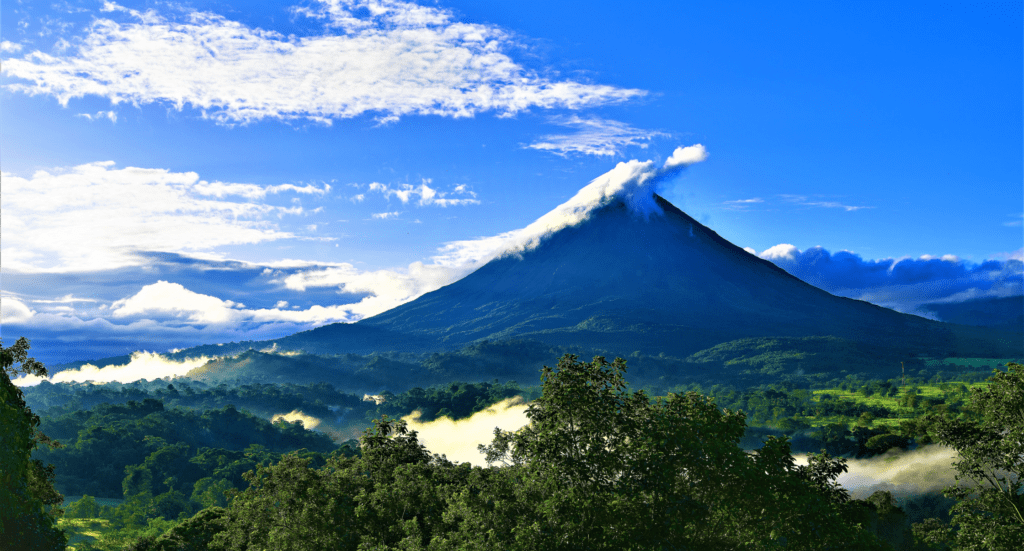
Why Does Everyone Love the Central Valley's Weather?
The Central Valley enjoys what many consider perfect weather year-round. At 1,000-1,500 meters elevation, temperatures rarely exceed 80°F or drop below 60°F. San José locals often joke they don’t own heavy coats or shorts – the weather never requires either extreme.
What Can You Expect Year-Round?
Daily patterns remain consistent:
- Cool mornings (60-65°F) perfect for coffee on the terrace
- Warm afternoons (75-80°F) without being oppressive
- Pleasant evenings that might require a light sweater
Dry season (December-April): Brilliant blue skies, almost no rain, perfect visibility for volcano viewing
Green season (May-November): Morning sunshine, afternoon showers typically starting around 2 PM, clear evenings by 6 PM
What does this mean for travelers? You can visit Central Valley attractions like Poás Volcano, coffee plantations, and San José any time of year. The main consideration is that afternoon clouds can obscure volcano views, so plan crater visits for early morning regardless of season. Coffee tours actually become more interesting during harvest season (November-February) when you can see the entire process in action.
For driving, Central Valley roads are well-maintained year-round. The biggest challenge isn’t the weather – it’s traffic around San José during rush hours (7-9 AM and 4-7 PM). What should be a 30-minute drive can easily become 90 minutes during peak traffic times.

Why Is the Caribbean Coast a Different World?
Costa Rica’s Caribbean coast operates on completely different weather patterns from the Pacific side. While the Pacific has predictable wet and dry seasons, the Caribbean does its own thing entirely. Humidity stays high year-round, but rainfall patterns are almost opposite to the Pacific.
When Does It Actually Rain on the Caribbean?
Understanding Caribbean Weather Patterns:
Driest periods: March-April and September-October (yes, when the Pacific is getting drenched)
Wettest months: November-January (opposite of Pacific patterns)
Temperature: Consistently 75-85°F with humidity that makes it feel hotter
Unique patterns: Can experience beautiful dry spells during Pacific’s rainy season
This creates interesting opportunities for savvy travelers. When the Pacific coast is getting drenched in October, Puerto Viejo might be experiencing beautiful sunny days. It’s like having a weather insurance policy – if one coast is wet, try the other.
Travel implications: The Caribbean coast requires different vehicle considerations year-round. High humidity means air conditioning becomes essential rather than optional – trust me, after an hour in a car without AC, you’ll be stopping every 20 minutes just to cool down. Many coastal roads are paved, but accessing beaches like Cahuita or Manzanillo involves some gravel sections that can become muddy during heavy rains.
For Tortuguero specifically, remember this destination is only accessible by boat or small plane regardless of weather – road access doesn’t exist. Either leave your rental vehicle in a secure lot in La Pavona or Caño Blanco for a daily rate (around $10-15 per day) or consider flying in or out of the so-called Amazon of Central America with arranged vehicle pick ups and drop offs to fit your plans. The boat journey itself becomes part of the adventure, but during heavy rains, it can be wet and bumpy.
What Makes the Northern Plains So Hot and Humid?
The Northern Plains, including the Arenal region, experience hot, humid conditions year-round with pronounced wet and dry seasons. This area sits in a geographical bowl that traps heat and moisture, creating its own microclimate.
How Do Seasonal Patterns Affect Arenal?
December through April: Hot and dry with excellent volcano visibility (when not cloudy)
May through November: Afternoon thunderstorms with morning clearing
Temperature ranges vary by elevation:
- Dry season: 70-88°F (cooler at higher elevations near the volcano)
- Green season: 68-85°F with higher humidity that makes it feel warmer
What affects your experience most? Arenal Volcano is notorious for hiding behind clouds. Your best chance for clear volcano views? Early morning (6-8 AM), regardless of season. By 10 AM, clouds typically start forming around the peak. Some visitors stay three days and never see the volcano clearly – it’s just part of Arenal’s mysterious charm.
Road conditions to Arenal from San José improve significantly once the rains start in May – dust settles and the landscape turns brilliant green, making for much more scenic drives. However, some adventure activities like canopy tours may be canceled during heavy afternoon storms. The hot springs, though? They’re actually better during rain – there’s something magical about soaking in hot water while cool rain falls on your face.
Why Is the Southern Zone So Extreme?
The Southern Zone, including the Osa Peninsula and Corcovado National Park, experiences some of Costa Rica’s most intense weather patterns. This is where Mother Nature doesn’t hold back.
What Should You Know Before Going South?
Extreme Seasonality Creates Unique Challenges:
January through April: Genuinely dry with minimal rainfall – the only time some areas are easily accessible
September through November: Extremely wet – sometimes receiving 200+ inches annually
This region sees Costa Rica’s heaviest rainfall, particularly around the Osa Peninsula. During peak green season, some areas become temporarily inaccessible due to flooding. We’re not talking about puddles – we’re talking about roads that become rivers and bridges that disappear under water.
Vehicle considerations are crucial here: The Southern Zone demands respect for weather patterns. Many roads to remote lodges and national park entrances require 4WD vehicles year-round, not just for traction but for water clearance. During heavy green season rains, even experienced drivers should consider flight connections to Puerto Jiménez or Drake Bay rather than attempting the long drive from San José. That adventurous spirit is great, but spending eight hours stuck in mud isn’t anyone’s idea of vacation.
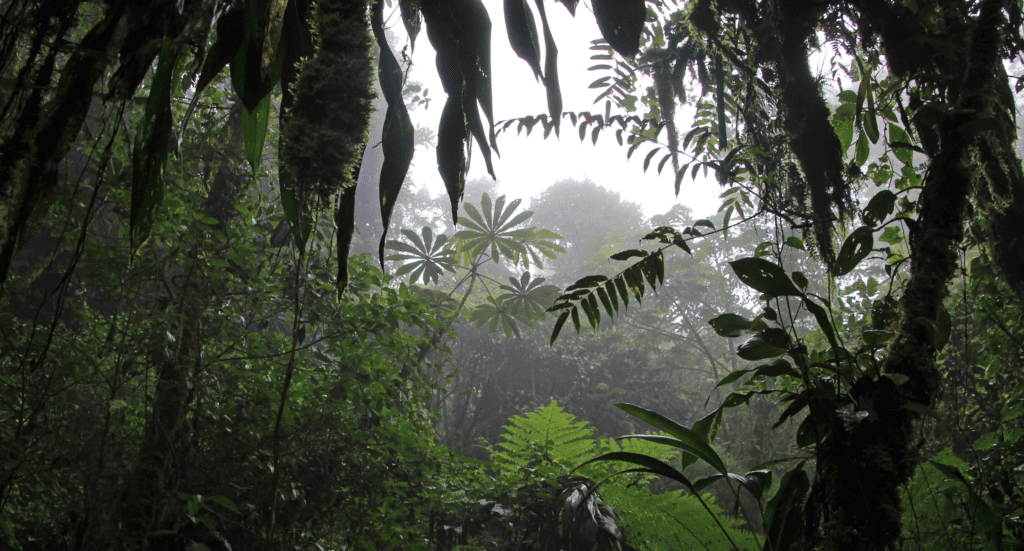
What's the Deal with Monteverde and Cloud Forests?
Cloud forests exist in a unique microclimate where temperatures stay cool year-round and humidity remains consistently high. This isn’t your typical rainforest – it’s a mystical world where clouds become part of the forest itself.
Why Is Monteverde Always Misty?
Monteverde Climate Patterns Never Really Change:
Temperature: 60-70°F year-round (pack that jacket!)
Characteristics: Misty conditions any time of year – it’s not a bug, it’s a feature
Dry season: Less rain but still misty/cloudy (hence “cloud” forest)
Green season: Frequent light rain and heavy mist that can reduce visibility to just meters
What does this mean for your visit? Pack layers regardless of when you visit. Monteverde can feel surprisingly cold, especially during evening and early morning hours. The famous “dry season” here still involves plenty of mist and occasional drizzle. Those Instagram photos of misty forests? That’s just Tuesday in Monteverde.
Road access to Monteverde requires careful consideration and patience. The final 25 kilometers involve steep, winding mountain roads with numerous potholes that locals navigate by memory. A 4WD vehicle provides much more confidence on this route, particularly during or after rains when potholes fill with water and their depth becomes impossible to judge. Some potholes are so legendary they have their own names among locals.
How Should Weather Guide Your Trip Planning Strategy?
Weather patterns should be the foundation of your Costa Rica itinerary, not an afterthought. Here’s how to plan strategically:
Want Guaranteed Sunshine?
Best regions: Guanacaste, Central Pacific
Best months: January-April
Vehicle needs: Any vehicle type works fine
Considerations: This is peak season – expect crowds and higher prices (sometimes double green season rates)
Looking to Avoid Crowds But Still Have Good Weather?
Best strategy: Visit Guanacaste in May-June or December
Alternative: Explore the Central Valley any time of year
Vehicle recommendation: Standard car sufficient for most destinations but an SUV offers higher clearance for those occasional puddles
Want the Best Value and Don’t Mind Some Rain?
Best approach: Green season travel (May-November) with strategic regional selection Smart combinations: Caribbean coast in September-October when Pacific gets heavy rains
Vehicle strategy: 4WD opens up more options during rainy season and provides peace of mind
How Do You Build a Weather-Smart Itinerary?
Here’s how weather patterns should influence your route planning for maximum enjoyment:
Multi-region trips: Start with mountain regions (Monteverde, Arenal) during clear morning hours, then head to beach destinations for afternoon relaxation when clouds roll in.
Rainy season travel: Plan indoor activities (museums, coffee tours, thermal hot springs) for afternoons when storms typically hit. Morning is your friend during the green season.
Photography considerations: Wildlife is most active during cooler parts of the day. Weather patterns affect animal behavior – many species become more visible during light green season rains when the forest comes alive.
Which Vehicle Do You Really Need for Different Weather?
Your rental car choice should factor in seasonal weather patterns and your specific destinations:
When Is a Standard Car Sufficient?
- Central Valley year-round (well-paved roads)
- Major Guanacaste beaches (Tamarindo, Papagayo) any season
- Manuel Antonio during dry season
- Main routes during dry season
When Should You Get 4WD?
- Monteverde year-round (road conditions, not just weather)
- Remote Guanacaste beaches during green season
- Southern Zone any time of year
- Any mountain destination during/after heavy rains
- Caribbean coast back roads any season
When Is 4WD Essential?
- Corcovado access points (no exceptions)
- Remote Osa Peninsula locations
- Highland destinations during peak green season
- Any off-the-beaten-path destination after heavy rains
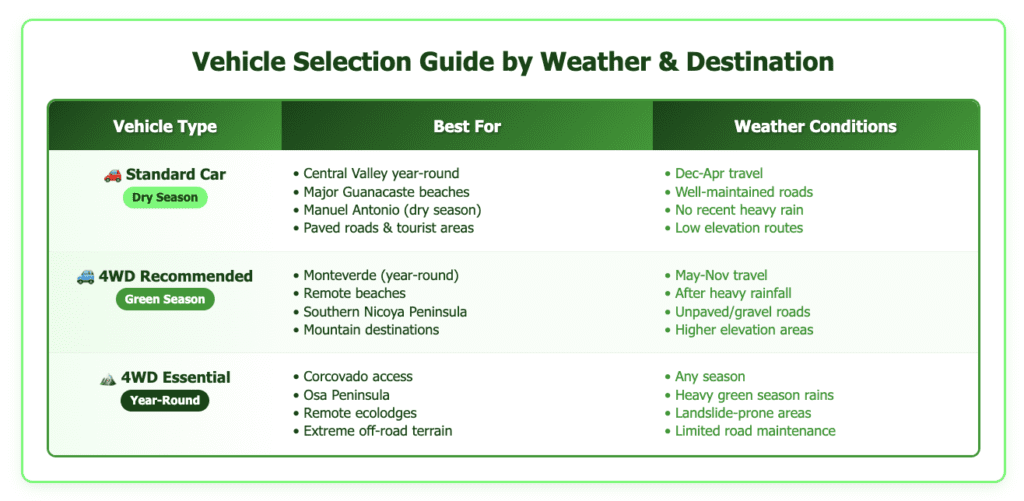
The key advantage of booking with a knowledgeable local rental company? Getting real-time advice about current road conditions and weather impacts. Costa Rica’s weather can change quickly, and having local experts who understand how recent rains affect specific routes proves invaluable. They’ll tell you when that scenic back road to the waterfall has turned into a muddy adventure best avoided.
What Should You Expect Each Month of the Year?
Understanding month-by-month patterns helps you plan around holidays, school schedules, and budget considerations:
January-February: Peak Dry Season
- Best for: Beach activities, volcano viewing, outdoor adventures
- Regions to prioritize: Guanacaste, Central Pacific, Northern Plains
- Vehicle needs: Any type works for most destinations
- Expect: Crowds, higher prices, guaranteed sunshine, need for advance reservations
March-April: Hot and Dry
- Best for: Those who love heat, water activities
- Regions to prioritize: Beaches, thermal hot springs (natural cooling off)
- Vehicle needs: Air conditioning becomes more important than 4WD
- Expect: Hottest temperatures of the year, very little rain, Easter Week crowds
May-June: Early Green Season
- Best for: Lush landscapes, fewer crowds, good value
- Regions to prioritize: Central Valley, early green season areas
- Vehicle needs: Standard cars still work for most areas
- Expect: Afternoon showers, spectacular green scenery, lower prices, friendly locals happy to see tourists
July-August: Veranillo (Little Summer)
- Best for: Balanced weather, moderate crowds
- Regions to prioritize: All regions experience drier spell
- Vehicle needs: Good time for any vehicle type
- Expect: Return to drier conditions, stable weather, North American summer vacation crowds
September-November: Peak Green Season
- Best for: Caribbean coast, indoor activities, budget travel
- Regions to prioritize: Caribbean side (drier), Central Valley
- Vehicle needs: 4WD opens up more options
- Expect: Heavy Pacific rains, lush landscapes, best prices of the year, some remote areas inaccessible
December: Transition Month
- Best for: Watching dry season return, holiday celebrations
- Regions to prioritize: Conditions improve throughout month
- Vehicle needs: Weather-dependent – check recent conditions
- Expect: Improving conditions daily, holiday crowds toward month-end, festive atmosphere
Ready to Plan Your Weather-Perfect Costa Rica Adventure?
Understanding Costa Rica’s regional weather patterns helps you make smarter decisions about when to visit, where to go, and how to get around. No more arriving at the beach during the rainiest month or missing volcano views because you didn’t know about morning clouds.
Start with your priorities: Do you need guaranteed sunshine for that perfect tan? Want to avoid crowds and don’t mind an afternoon shower? Hoping to see green, lush landscapes at their peak? Your weather preferences should drive your timing and regional selection.
Consider shoulder seasons: May-June and November-December often offer the best balance of good weather, reasonable crowds, and fair prices. These months give you the sweet spot that experienced travelers know about.
Plan for microclimates: Remember that you can experience multiple climate zones in a single day of driving. Pack layers and expect temperature changes as you move between elevations. That morning in chilly Monteverde could end with a sunset swim in warm Tamarindo.
Choose your vehicle wisely: Weather patterns directly affect road conditions. A 4WD vehicle gives you more flexibility during the green season, while standard cars work fine during the dry season on main routes. The right vehicle choice prevents the weather from limiting your adventure options.
Ready to plan your Costa Rica adventure around the perfect weather for your travel style? Understanding these regional patterns helps you time your visit for the experiences you want most – whether that’s guaranteed beach days, misty cloud forest hikes, or budget-friendly green season exploration.
For more specific guidance on timing your visit to individual destinations, check out our comprehensive guide to Planning the Ultimate Costa Rica Vacation, or explore our seasonal travel tips for detailed insights on making the most of each time of year.
